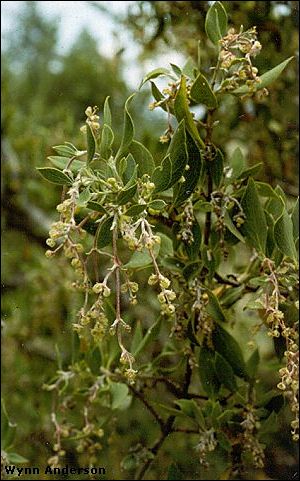
A distant, superficial view of typical Chihuahuan Desert scenes reveals little of its enormous variety of plant life. Full realization of the diversity requires investigation of the many different habitats tucked away here and there. A flatland has relatively few ways in which it can vary--mostly differences in the presence of different soil types and variations in moisture distribution. Mountains, however, multiply habitat diversity almost beyond belief. Solar input changes with each individual slope, soil types and thicknesses may vary radically over only a few feet, and the steepness of the terrain magnifies the differences in moisture availability.
Wright Silktassel is one of the many plants found in our desert ranges
that takes advantage of the mountain scene. Wander into the canyons of the Franklin
Mountains, where it is common, and this 3- to 9-foot tall, evergreen shrub is sure to
attract the eye. Among its attributes are purple berries, food for wildlife. But look
close—not all trees bear such fruit, for like us, some individuals are males and some
are females.
![]()
Contributor: Arthur H. Harris, Laboratory for Environmental Biology, Centennial Museum, University of Texas at El Paso.
Desert Diary is a joint production of the Centennial Museum and KTEP National Public Radio at the University of Texas at El Paso.

Wright's Silktassel (Garry wrightii). Photograph by Wynn Anderson.